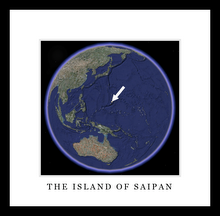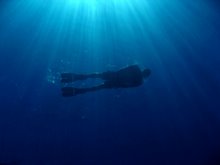
I had a great trip to Hawaii to celebrate my parent's 40th wedding anniversary, and one of the highlights was taking my 4 year-old nephew Alex out snorkeling where he got to see his first sea turtle! I'm not sure who was more excited, me or him. I did manage to dive down and get this great picture of him looking down at the turtle. It took a couple of days to talk him into braving the scary ocean waters, but once he did it I think he was pretty excited, though he decided to stick to the safety of his boogie board/viewing platform.

I was amazed at how "tame" the Hawaiian Green Sea Turtles (Chelonia mydas) were in comparison to the turtles here in Saipan. The green's I've seen here in Saipan tend to bolt in the presence of people, whereas these turtles didn't seem to mind at all that I was swimming around them. Of course, knowing that these are an endangered species and that they are protected by the federal Endangered Species Act, we made sure to keep our distance and to not disturb or harass them in any way. But even so, at one point as I was snorkeling with my brother John I was startled when I looked down because a large female was about 2 feet from my leg and had just drifted right up alongside me without my knowing it. I would have to guess that the turtles in Saipan might be a bit more weary of people since they do still get occasionally poached here. The difference in their behavior is pretty obvious, whatever the cause.
Another big difference between the turtles here in Saipan and the ones I saw in Maui is that many of the Maui turtles I saw were infected with the fibropapilloma virus, which is a wart-like virus that is unfortunately increasing in prevalence in Hawaiian sea turtles. The first Hawaii case was reported in 1958, and incidences of the virus have increased in number and geographical range ever since. The virus causes large tumors to grow on the turtles, usually beginning on their eyes and spreading to the neck and flippers. The tumors can block the turtle's vision, can impede eating when on the mouth, and can eventually lead to emaciation and death. The Kahului Bay area, where we were snorkeling, is known to have a high incidence of this disease.
When I was studying at the University of Hawaii in Hilo, I had the opportunity to spend a couple days working alongside Dr. George H. Balazs, who is the famous "Turtle Doctor" of Hawaii. It was an amazing once-in-a-lifetime opportunity to get to hand-catch turtles in the wild and bring them in for their "yearly physical" on the beach with the Turtle Doctor! That was the first time I had ever been that close to a turtle. Mind you, the researchers had to go through a lengthy federal permitting process in order for us to be able to handle or even touch the turtles, and we were all trained in the proper procedures so no turtles were harmed. Normally any contact with a turtle would be illegal. The turtles got weighed, measured, scanned for tags, tagged if they had none, and checked for disease. We did not see any evidence of fibropapilloma on the turtles we caught and tagged, which was a good sign.
My other working experience with turtles was while I was at Duke at the Duke University Marine Lab in Beaufort, NC. There I worked on a project with Dr. Larry Crowder, and it was my responsibility (along with a few classmates) to take care of 500 baby Loggerhead Sea Turtles (Caretta caretta) that we were raising for a sex ratio study. Sea turtles are curious critters because their being male or female is not a genetic thing, like it is in humans with our X and Y chromosomes, but rather it has to do with the presence or absence of testosterone and estrogen while they are developing in the egg. Sea turtles lay their eggs in the sand on beaches, and the temperature of the nest determines whether or not they will be male or female. At higher temperatures, the enzyme that converts estrogen to testosterone breaks down and the turtle will be a female. At colder temperatures, that enzyme sticks around and converts the estrogen to testosterone and the turtle will hatch a male. At least that's how I remember it! But the catch is that with turtles you can't tell if they are male or female until they are large. Males have much longer tails than females do. So when a nest hatches, you have no way of knowing how many are males and how many are females. But of course my ingenious professor at Duke figured out a way! Along with another professor from Florida Atlantic University, Dr. Jeanette Wyneken, they designed an "experiment" where they took 1,000 hatchlings, right as they hatched, and raised them in labs at Duke and FAU for a few months. When they are a few months old, their sex organs finally start to differentiate into male and female. But those are internal, of course, just to make things harder! So we (and by we, I mean the Doctors) had to perform a laproscopy (basically like an arthroscopic surgery) on these little turtles in order to get a peek at their internal private parts. We had a sterile operating room set up with 2 or 3 marine veterinarians, along with the researchers and a crew of helpers. After the turtles were stitched up, we let them recover for a few weeks before releasing them into the Gulf Stream where they would have been had we never scooped them up off the beach. Because of this experiment, they were able to get some invaluable data on the sex distribution of sea turtles all along the U.S. east coast. This was the first time anything like this had been done. They could also use the data to predict the sex ratio of males to females in the adult turtle population.
Now with all the talk of Global Warming, you might start to wonder if rising sea and land temperatures could change the sex of sea turtles. That was one of the driving forces behind the study. As things warm, we might be seeing more and more female turtles being born without the males. Some researchers are even suggesting that a warming of 7 degrees F could eliminate male sea turtles altogether. So turtles could be another potential victim of Global Warming. Isn't it about time we get serious about addressing it? So many of our precious natural resources are at risk, not to mention the potential human toll. Living on a small island where the impacts could be so severe really changes your perspective on things. My friend and colleague Albon who lives in the Marshall Islands has it even worse ... their highest point is only a few meters above sea level! So anyways, that's what I was doing for a few months in a lab in NC after I finished graduate school. Pet-sitting 500 baby sea turtles.





5 comments:
Very cool picture of your nephew with the turtle! And I like the fact that you used your blog to educate about turtles. I would think this would be a good outlet of that fancy degree of yours.
Looks like you had a great time=) Even more great is that you got to pet sit 500 baby turtles!
Your lengthy story about sea turles was very fascinating Ocean Man ;) You're too smRt for your own good.
And your little nephew is sooo very cute. Wish I could've been there to see the sea turtles tha close.
Since I'm somewhat responsible for you having to do another blog entry anyway, I figured I might as well tag you and make you do another. Check my 7-3-07 blog for details.
hey greg, awesome pictures by the way. i checked out the bali pics. we're heading there on the 22nd for a 9 day trip. can't wait. not nearly as spontaneous as you though with kid in tow but we are very excited.
Post a Comment